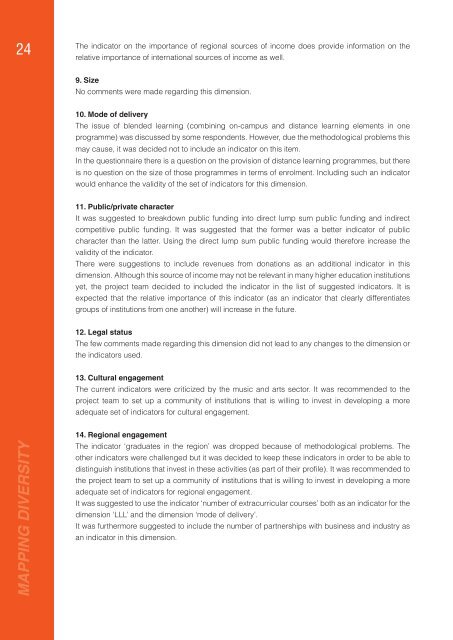Mapping Diversity: Developing a European Classification of ... - U-Map
Mapping Diversity: Developing a European Classification of ... - U-Map
Mapping Diversity: Developing a European Classification of ... - U-Map
You also want an ePaper? Increase the reach of your titles
YUMPU automatically turns print PDFs into web optimized ePapers that Google loves.
24<br />
The indicator on the importance <strong>of</strong> regional sources <strong>of</strong> income does provide information on the<br />
relative importance <strong>of</strong> international sources <strong>of</strong> income as well.<br />
9. Size<br />
No comments were made regarding this dimension.<br />
10. Mode <strong>of</strong> delivery<br />
The issue <strong>of</strong> blended learning (combining on-campus and distance learning elements in one<br />
programme) was discussed by some respondents. However, due the methodological problems this<br />
may cause, it was decided not to include an indicator on this item.<br />
In the questionnaire there is a question on the provision <strong>of</strong> distance learning programmes, but there<br />
is no question on the size <strong>of</strong> those programmes in terms <strong>of</strong> enrolment. Including such an indicator<br />
would enhance the validity <strong>of</strong> the set <strong>of</strong> indicators for this dimension.<br />
11. Public/private character<br />
It was suggested to breakdown public funding into direct lump sum public funding and indirect<br />
competitive public funding. It was suggested that the former was a better indicator <strong>of</strong> public<br />
character than the latter. Using the direct lump sum public funding would therefore increase the<br />
validity <strong>of</strong> the indicator.<br />
There were suggestions to include revenues from donations as an additional indicator in this<br />
dimension. Although this source <strong>of</strong> income may not be relevant in many higher education institutions<br />
yet, the project team decided to included the indicator in the list <strong>of</strong> suggested indicators. It is<br />
expected that the relative importance <strong>of</strong> this indicator (as an indicator that clearly differentiates<br />
groups <strong>of</strong> institutions from one another) will increase in the future.<br />
12. Legal status<br />
The few comments made regarding this dimension did not lead to any changes to the dimension or<br />
the indicators used.<br />
13. Cultural engagement<br />
The current indicators were criticized by the music and arts sector. It was recommended to the<br />
project team to set up a community <strong>of</strong> institutions that is willing to invest in developing a more<br />
adequate set <strong>of</strong> indicators for cultural engagement.<br />
MAPPING DIVERSITY<br />
14. Regional engagement<br />
The indicator ‘graduates in the region’ was dropped because <strong>of</strong> methodological problems. The<br />
other indicators were challenged but it was decided to keep these indicators in order to be able to<br />
distinguish institutions that invest in these activities (as part <strong>of</strong> their pr<strong>of</strong>i le). It was recommended to<br />
the project team to set up a community <strong>of</strong> institutions that is willing to invest in developing a more<br />
adequate set <strong>of</strong> indicators for regional engagement.<br />
It was suggested to use the indicator ‘number <strong>of</strong> extracurricular courses’ both as an indicator for the<br />
dimension ‘LLL’ and the dimension ‘mode <strong>of</strong> delivery’.<br />
It was furthermore suggested to include the number <strong>of</strong> partnerships with business and industry as<br />
an indicator in this dimension.

















